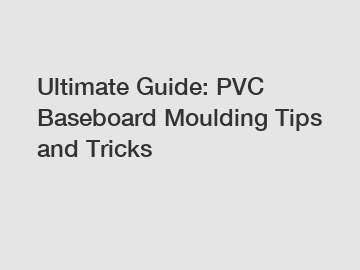Ultimate Guide: PVC Baseboard Moulding Tips and Tricks
Ultimate Guide: PVC Baseboard Moulding Tips and Tricks?
Are you looking to enhance the aesthetic appeal of your home with stunning baseboards? If so, PVC baseboard moulding might be the perfect solution for you. In this ultimate guide, we will share some valuable tips and tricks to help you make the most out of this versatile material. From installation to maintenance, we've got you covered. Let's dive in!
1. What is PVC Baseboard Moulding?

PVC (polyvinyl chloride) baseboard moulding is a type of trim used to cover the joint between a wall and the floor. It is considered an excellent alternative to traditional wood or other materials because of its durability and low-maintenance properties. PVC baseboard moulding is resistant to moisture, rot, and termite damage, making it an ideal choice for areas prone to high humidity, such as bathrooms and kitchens.
2. Choosing the Right PVC Baseboard Moulding.
When selecting PVC baseboard moulding, several factors need to be considered. Firstly, determine the desired style and design that will complement your home's overall interior. PVC baseboards come in various sizes, profiles, and finishes, allowing you to achieve the perfect look. Additionally, ensure the measurements of the baseboards match your room's dimensions. Remember, accurate measurements are crucial for a professional-looking installation.
3. Installation Tips and Tricks.
Installing PVC baseboard moulding is a relatively straightforward process, even for beginners. Follow these steps to ensure a successful installation:
- Prepare the area: Before starting the installation, make sure the wall and floor are clean and free from any debris. Remove any existing baseboards carefully.
- Cut the baseboard: Measure and mark the PVC baseboard according to your required length. Use a miter saw or a miter box to make clean and precise cuts.
- Test-fit the baseboard: Place the cut piece against the wall to ensure it fits perfectly. Make any necessary adjustments before proceeding.
- Apply adhesive: Apply a high-quality adhesive, designed specifically for PVC baseboard moulding, onto the back of the baseboard. Be sure to follow the manufacturer's instructions.
- Install the baseboard: Press the baseboard firmly against the wall, starting from one end and gradually moving towards the other. Use a level to ensure the baseboard is straight.
- Secure with nails or screws: Once the adhesive has dried, secure the baseboard further by using nails or screws along the top edge. Remember to countersink the nails or screws and fill the holes with a matching putty for a seamless finish.
- Apply caulking: To achieve a professional look, use a high-quality caulk to fill any gaps between the baseboard and the wall or floor. Smooth the caulk with a caulk finishing tool or your finger.
4. Maintenance and Cleaning.
One of the significant advantages of PVC baseboard moulding is its low-maintenance nature. Cleaning PVC baseboards is a breeze and requires minimal effort. Regularly dusting the baseboards with a soft cloth or dry mop will keep them looking fresh. For stubborn stains or grime, use a mixture of mild soap and water, gently scrubbing the affected area. Avoid using abrasive cleaners or harsh chemicals, as they may damage the PVC material.
In conclusion, PVC baseboard moulding can be a game-changer when it comes to enhancing the elegance of your home. With its durability, moisture resistance, and ease of maintenance, it is a fantastic choice for any room. Remember to choose the right style, follow the correct installation process, and maintain your baseboards properly. By incorporating these tips and tricks into your project, you can achieve flawless results that will leave your guests amazed. So, why wait? Upgrade your home with PVC baseboard moulding today!
Are you interested in learning more about 4 inch skirting board, p50 skirting detail, foam skirting board? Contact us today to secure an expert consultation!

Comments
0